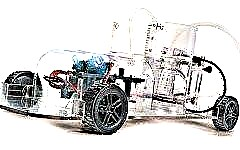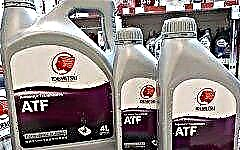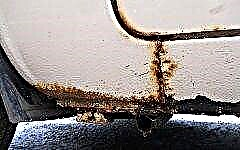

The content of the article:
- Types of anticorrosives
- The best products for treating the external surfaces of the car
- The best means of protection for internal body cavities
Anti-corrosion treatment of the body remains the most reliable protection of the car against premature aging. Not all manufacturers use the hot-dip galvanizing method in the production of their models. If the first foci of corrosion on the thresholds and arches of European cars can be seen after 3-4 years, then cars from China begin to rot after 1.5-2 years.
What corrosion protection products can be used for underbody, sills, wheel arches and cavities? We offer TOP-9 of the best means for treating a car against corrosion.
Types of anticorrosives

The modern market offers hundreds of products for treating metal body parts against premature corrosion. For internal and external surfaces, different classes of anticorrosive materials are used. Compounds for internal pockets of the bottom, side members, struts displace moisture from the closed cavity and have a high elasticity index.
The materials do not harden, they cover the inner surface with a protective film. Processing takes place with a pneumatic pistol, if the product is in a can, or with an aerosol can through a technical opening, the anticorrosive is poured into the cavity. The main component in the production of such protection is paraffin, oil, silicone.
Anti-corrosion agents for external treatment of the body: the bottom, wheel arches, the outer part of the sill have a dense composition, bitumen mastic, rubber base, organic and synthetic resins are used as the material.
The composition creates a dense elastic film with a thickness of 1 cm, which prevents the penetration of salt reagents, protects the bottom and thresholds from mechanical damage by flying gravel during movement.
The best products for treating the external surfaces of the car

In the photo: Dinitrol 479
- Dinitrol 479;
- Tectyl;
- Hi Gear;
- Liqui Moly;
- Body 930.
Dinitrol 479
Dinitrol 479 is made on the basis of synthetic rubber with the addition of polyurethane glue and corrosion inhibitors. The anticorrosive material of the German manufacturer is of high quality and long service life - it protects the metal for up to 3 years. Wheel arches and sills are often sprayed with aerosol.
The price of protection is quite high; for a complete treatment of the bottom, 7-8 cylinders are required. Anticorrosive has high adhesion, when spraying, a large number of micro air bubbles are formed, which, after hardening, provide sound insulation of the wheel arches.
To ensure reliable protection of the body, it is necessary to carry out a full range of preparatory work. All Dinitrol anticorrosive materials require a well-prepared surface, so the composition is recommended to be used for new cars.
Tectyl UA VE20050
Waterproof anticorrosive for the bottom of the production of the Netherlands. The product is available in aerosol cans and five-liter buckets. For complete processing of the bottom under a brush, packing in a bucket is selected, the price is from 3000 rubles.
Anticorrosive mixture is made on the basis of bitumen with the addition of mineral oil, calcium soap and white spirit solvent. The composition forms an elastic protective film that displaces moisture, preserves possible foci of rust. Due to its high adhesion and elasticity, it protects the bottom from gravel scratches, prevents the penetration of salt reagents in winter.
Tectyl UA VE20050 has a long service life, retains the elasticity of the inner layer at a temperature of minus 30 degrees. Often used for cars over 7 years old, it contains a high percentage of corrosion inhibitors that stop rust.
Masters recommend applying Tectyl in 3 coats or using an additional bitumen mastic for the outer layer, since the product applied in 1 coat will not provide sufficient protection against mechanical damage.
Hi Gear
Anti-corrosion compound for the treatment of sills, side members and arches. The material uses synthetic rubber, polymers, corrosion inhibitors. The tool is most effective in the treatment of welded seams, the composition ensures surface tightness, preserves rust, and retains its properties for up to 3 years.
It is produced in aerosol cans, therefore it is not used for complete bottom treatment. It is recommended to apply anticorrosive in at least two layers.
Despite its high adhesion and resistance to chemicals, the elastic film is penetrated by gravel when driving at high speed. Hi Gear is considered to be the best wheel arch noise dampener.
Liqui Moly 6112
One of the best bituminous anticorrosive agents on the market for bottom treatment. Produced in liter buckets, application method - pneumatic gun. A viscous composition with a large amount of volatile compounds quickly fills microcracks, after drying it remains elastic.
Anticorrosive has high strength against mechanical damage, rust inhibitors prevent the spread and occurrence of electromechanical and chemical corrosion. Due to its ease of application, it is used on cars over 5 years old.
The aerosol composition of Liqui Moly Unterboden-Schutz Bitumen schwarz is more often used to protect wheel arches and sills on new cars. It is applied in 2 coats, requires careful preparation of the surface.
Body 930
Comprehensive underbody protection will be provided by the anticorrosive Body 930 made in Greece. The composition is applied to external surfaces with a brush or pistol. Body 930 refers to budgetary means of protection, the price of a 5-liter bucket is 1,700 rubles.
Anticorrosive has high adhesion, after drying it creates a strong protective film with a thickness of at least 1 cm. The composition is resistant to chemical compounds, prevents moisture penetration.
The only drawback of the tool is the service life of no more than 1.5 years.
The best means of protection for the internal cavities of the body

In the photo: Tectyl ML
- Dinitrol ML;
- Liqui Moly Hohlraum-Versiegelung;
- Tectyl ML;
- Movil.
Dinitrol
Anticorrosive Dinitrol for internal cavities forms a strong elastic film, easily penetrates into microcracks, does not drain at high temperatures. The anti-corrosion protection contains synthetic components that are not aggressive to paintwork and rubber parts. Thanks to corrosion inhibitors, the composition reliably preserves existing rust.
The manufacturer recommends to apply anticorrosive in one layer, reapplication can be carried out after a year using the "Dinitrol 1000" composition, without cleaning or removing the first coating.
Liqui Moly Hohlraum-Versiegelung
A distinctive feature of the anticorrosive agent for internal cavities of the LiquidMolly composition is its good penetrating properties. It is enough to spray the aerosol once to get full metal protection.
Repairers recommend using anticorrosive material for internal sill and side member pockets, but not for wheel arches. Hohlraum-Versiegelung forms a very thin film after hardening, for the wheel arches you will need to use an additional protective agent that is resistant to mechanical damage.
The composition is based on a weakly thixotropic liquid with high water-repellent properties; after drying, a strong elastic film is formed. The anticorrosive material sinks into rust and preserves the centers of corrosion. Due to its resistance to salt, the protection service life is up to 2 years.
Tectyl
Tectyl manufactures anti-corrosion formulations for internal body cavities in 600 ml aerosol cans. One cylinder is enough for pockets of thresholds, doors, spars. The product has one of the highest adhesion rates, does not drip from the surface, quickly penetrates into closed grooves and forms a protective film up to 3 mm thick.
The manufacturer recommends using anticorrosive for new cars, where there are no traces of primary rust. The paraffin-based composition does not preserve existing foci of corrosion - this is the only drawback of the product.
At the same time, the composition reliably protects the surface from moisture, does not deteriorate from salt and chemical reagents for a long time. Average term of work is 3 years.
Movil
Anti-corrosive Movil, proven by time and thousands of motorists, continues to be popular. This is one of the most demanded products for the treatment of cavities for cars over 7-10 years old. The composition quickly penetrates into microcracks, has average adhesion rates, is resistant to temperature extremes, does not corrode car enamel and rubber parts.
The main disadvantage of the budget anticorrosive is insufficiently active penetration into the existing rust. If there is a corrosion center in the spar or sill, Movil will not mothball it, but will stop its propagation. If you pour the agent inside the threshold, you will need to periodically update the coating - the oil base contributes to the gradual drainage of the anticorrosive.
Conclusion
When choosing a means for treating a car against corrosion, it must be borne in mind that the coating will provide reliable protection of the body only after thorough surface preparation. It is necessary to wash the body, remove rust spots, dry thoroughly and only then start spraying the anticorrosive agent.











